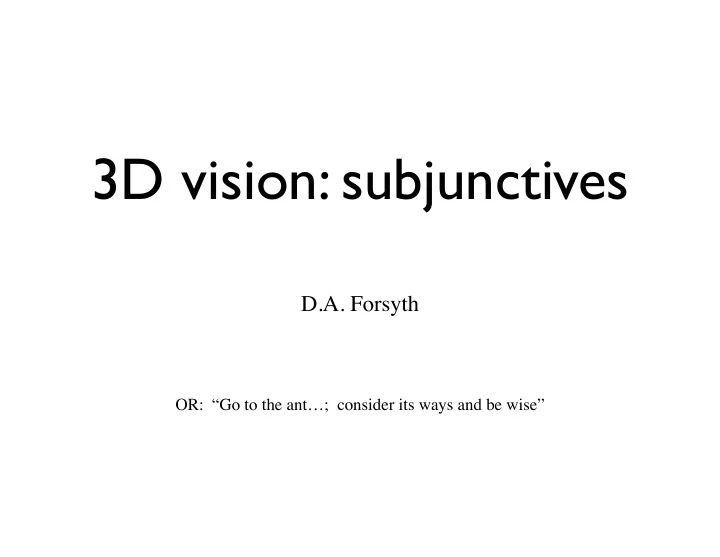

3D vision: subjunctives D.A. Forsyth OR: “Go to the ant…; consider its ways and be wise”
What does vision do? (traditional) • Recognition • instances (who is this?) • allocate pictures of objects to categories (classification) • find location of objects in pictures (detection) • produce descriptions of objects (attributes/primitives) • describe pictures (captioning) • Reconstruction • SLAM • point clouds • meshes • voxel reconstructions • geometric primitives • implicit surfaces, generalized cylinders, superquadrics, etc. • Lots of evidence these threads interact • Lots of evidence that these activities have created value
What are we really good at? • Classification • eg image classification; voxel labelling; detection (== lots of classification) • in the presence of huge quantities of labelled data • Regression • eg predicting boxes; depth; voxels; etc. • in the presence of huge quantities of labelled data • (Some kinds of) Geometric reasoning • SFM writ large • Our actions are driven by our tools (OADOT)
What are we bad at? • (Almost) Unsupervised learning of visual representations • Controlling the bias of representations for advantage • Will reinforcement learning save us? • NO
OADOT - Recognition • Categories clearly don’t exist in any canonical sense • and any instance can belong to many different categories, etc. • be very careful of: • members of a category share properties or are alike • what properties? in what sense alike? • And so *MUST* be the product of unsupervised learning • Categories are useful intermediaries • it is helpful to group instances together in clusters that • improve prediction • dog-a will very likely behave in the same way as dog-b • improve communication • it’s easier to talk about dogs than dog-a, dog-b
OADOT - Reconstruction • Reconstructions don’t exist in any canonical sense, either • there really isn’t any single 3D representation cause there can’t be • there is no evidence that *any* visual task *requires* a 3D rep’n • Q: how can you determine *from outside* whether an agent has one? • 3D representations are intermediaries • and useful to the extent they mediate • eg: point clouds, meshes • renderable models; metric info; maps • What task does this representation facilitate? • what info does the task need?
What problems to focus on? • Improved geometric models from images is always good • there’s a reason to care, etc. • Orphan problems • The space we can’t see • How do I know there is a 3D world? • Functional problems • Where am I? • How do I get home? • What could I do? • What might happen?
The space we can’t see • Speculated depth • what would depth map look like if an object was removed? • what is behind closest object? • could I move there?
How do I know there is a 3D world? • and how to act in it? • (without invoking RL) • Various answers: • 3D means textures are more uniform (Fouhey et al 15) • the parametric forms of flow fields are more easily explained (Gibson, 50) • Do I need to know there is a 3D world?
� Where am I? • This doesn’t get sufficient credit as 3D • early work (im2gps, etc; Hays+Efros 2008) • non-par regression (matching) • NOT the same as building a map • Short scales, visually simple worlds are hard • get different visual sensors and use them well • Mantis shrimp (Daly et al 2016)
• Movie
How do I get home? • Desert ants can forage, then go home directly • They’re not doing SLAM! (scale) • Cues: • dead reckoning (count leg movements) • visual waypoints • polarization based sun compass • Behavior can be explained *without* a map • multiple cues each produce a “go-home” vector • weighted combination (Hoinville+Wehner, 2018) • can be imitated (Dupeyroux et al 2019) • And they can go home backwards
• Movie
What can I do? • Path planning is not about geometric detail • which creates computational complexity • RRT methods; nearest neighbor methods; = strategies to duck detail • the key is a test: will this result in collision? • So why recover detail from images, rather than be able to answer query? • We should recover geometric affordances of objects • what can be done to this, and where? • this likely isn’t inherited from category • Does a clam shell have a “hit here” tag?
• Movie
What might happen?
Conclusions • What we do is shaped too much by our tools • collect dataset - regress - repeat • 3D representations are mostly intermediaries • the ones we use should be task appropriate, not generic • Appealing problems: • The space we can’t see • How do I know there is a 3D world? • Where am I? • How do I get home? • What could I do? • What might happen?
Structure • traditional view: • recognition • instance: - useful for some special cases • categories: - clearly don’t exist in any canonical sense, but are very useful intermediaries • reconstruction • various geometric representations: - typically intermediaries • lots of evidence of interaction • What can we do? • regression • classification • both really well, in the presence of large, labelled datasets
Structure • what should vision do? • inform action • pure reinforcement learning is ridiculous, so representations are needed • what to recover? • current geometric representations are inconvenient devices • perhaps • break out representations by the problems they can be used to solve • exploration • going home • interaction • prediction
Recommend
More recommend